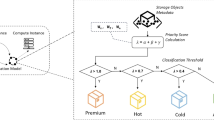Abstract
Combinatorial reasoning is applied to the analysis of two kinds of dynamic storage allocation system to derive results about the degree and characteristics of memory fragmentation. The simple first-fit scheme with immediate replacement, discussed by Knuth, is analyzed further, providinginter alia a new derivation of the “fifty percent rule”. Next a system with garbage collections is considered, and the mean and variance of the number of holes following a garbage collection are determined, along with other results. The cell distributions resulting from these two idealized policies are contrasted.
Similar content being viewed by others
References
D. E. Knuth,The Art of Computer Programming, Vol. 1,Fundamental Algorithms, Addison-Wesley Publishing Co., Reading, Mass., 1968.
J. E. Shore,Anomalous behaviour of the fifty-percent rule in dynamic memory allocation, Comm. A.C.M. 20 (Nov. 1977), 812–820.
P. J. Denning,Virtual memory, Computing Surveys 2 (Sept. 1970), 153–189.
B. H. Margolin, R. P. Parmelee and M. Schatzoff,Analysis of free-storage algorithms, IBM Syst. J. 10 (1971), 283–304.
W. Feller,An Introduction to Probability Theory and Its Applications, Vol. 1, 3rd Ed., J. Wiley & Sons, New York, 1968.
A. M. Mood,The distribution theory of runs, Annals. of Math. Statistics 11 (1940), 367–392.
N. L. Johnson and S. Kotz,Discrete Distributions, Houghton Mifflin Co., Boston, 1969.
D. J. M. Davies,POP-10 user's manual, Department of Computer Science, Computer Science Report #35, The University of Western Ontario, London, Canada, 1976 (revised 1979).
A. C. Hearn,REDUCE 2 user's manual, Report UCP-19, University of Utah, Salt Lake City, Utah, 1973.
Author information
Authors and Affiliations
Additional information
This research was supported in part by the National Science and Engineering Research Council of Canada under an operating grant.
Rights and permissions
About this article
Cite this article
Julian, D., Davies, M. The fifty percent rule revisited. BIT 20, 279–288 (1980). https://doi.org/10.1007/BF01932770
Received:
Revised:
Issue Date:
DOI: https://doi.org/10.1007/BF01932770




